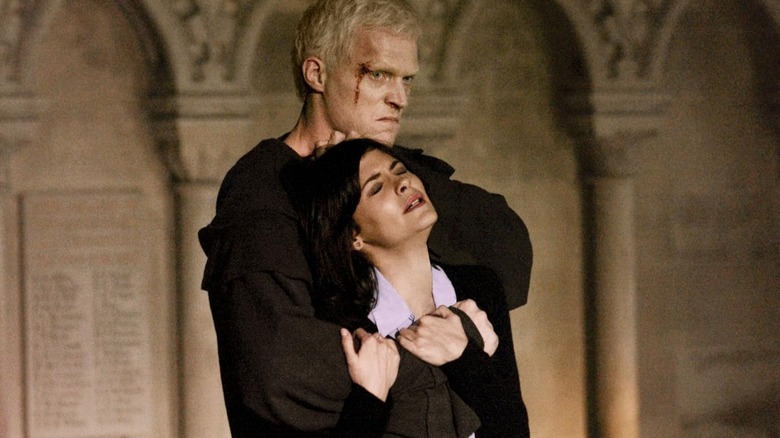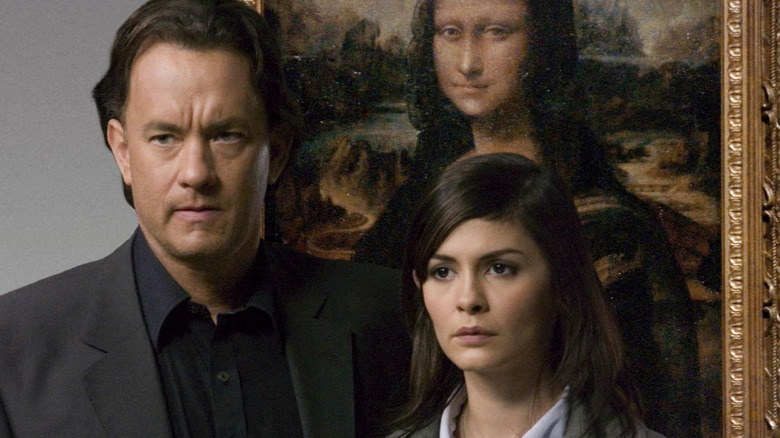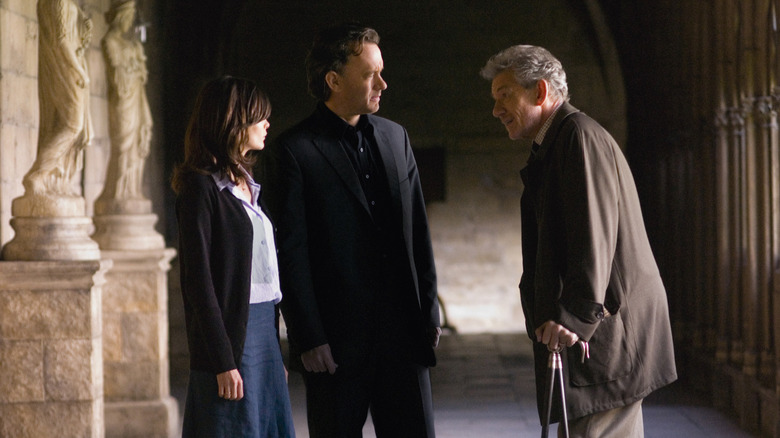A Controversial Tom Hanks Box Office Hit Was Banned In Multiple Countries

When Dan Brown’s museum-mystery thriller “The Da Vinci Code” was published in 2003, it quickly became the new King of the Airport Novels, present in the hands of every beach vacationer and long-distance commuter in the country. Brown essentially blended the religious esoterica of Umberto Eco’s “Foucault’s Pendulum,” but ran it through a pulpy Michael Crichton machine, creating a historical potboiler to end all historical potboilers.
The story involved a “symbologist” named Robert Langdon who is alerted to secret clues at a murder scene at the Louvre, called there because of his field of expertise. Langdon was altered by Sophie Neveu, a police cryptographer who has a secret connection to the victim, as she feels there is a deeper mystery afoot. The pair sneak away from the crime scene, and begin to uncover secret messages planted around the museum, eventually leading them to a string of increasingly oblique secrets that might have something to do with the history of the Catholic Church. We’ll get to the actual twist ending in a moment. There are secret safety deposit boxes, secret letter-based puzzle devices, an eccentric expert in the Holy Grail named Teabing, and a vicious albino assassin monk.
Ron Howard adapted “The Da Vinci Code” into a feature film in 2006, starring Tom Hanks as Langdon and Audrey Tautou as Neveu. The film, like the book, was a massive hit, earning $760 million worldwide on a $125 million budget. The film wasn’t well-reviewed, but audiences loved the pulpy silliness of it.
Not everyone was fond of it, however. Catholic groups, Coptic groups, and other religious organizations all over the world protested Howard’s film, feeling it espoused blasphemous or merely critical depictions of the Catholic Church. It seems that one can get in trouble for merely suggesting that Jesus Christ not only married Mary Magdalene, but that they had children together. That conceit got the film banned.
The Da Vinci Code was protested for its theories about Christ’s children
To elucidate, “The Da Vinci Code” initially seems to have a mystery that alludes to the Holy Grail, but a twist in the narrative reveals that it was not the Grail in the ancient texts, but Mary Magdalene herself. Some additional puzzle-like evidence, paired with some barely remembered childhood traumas, reveal evidence that Christ had children with Mary Magdalene, and that their descendants were walking the Earth today. Notably, Opus Dei, an organization within the Catholic Church — and featured heavily in the film — wanted to cover up Christ’s descendants, and were willing to kill to keep the secret.
First and foremost among the protestors was the Vatican itself, who, in a 2006 issue of the Catholic World News, said that the film was full of “calumnies,” and that it was historically inaccurate. Opus Dei also stepped forward to demand a disclaimer be added to the beginning of the film, stating that they are not, in reality, a secret cabal of violent conspiracy-hoarders. Meanwhile, Catholic bishops in the United States launched a website called JesusDecoded.com, which, in a gentler fashion, debunked all the inaccurate historical hypotheses that Dan Brown suggested.
Of course, Catholics weren’t up in arms over mere historical inaccuracies, but a fundamental depiction of Jesus Christ. While there is no mention of Christ’s children in the extant Gospels, the implication that he might have married and had kids draws him away from the Divine and more toward humanity, something the Catholic Church deeply objects to. Theories about Christ’s marriage to Mary Magdalene go all the way back to the twelfth century Gnostic teachings, and many feel it’s blasphemous to depict Christ as having sex or dallying with sin.
The Da Vinci Code was banned around the world
Other organizations were far more draconian than the above-mentioned American bishops. Catholic groups in Pakistan and India called for the film to be banned, as it not only insulted Catholic doctrine, but also interfered with Islamic teachings. The protests in India came from a northeastern part of the country that is predominantly Catholic, even though the bulk of the country is Hindu. The film was also banned in Sri Lanka, after the island nation’s president received a letter of complaint from the Catholic bishops in his country.
Coptic Christian groups in Egypt protested “The Da Vinci Code,” and they went so far as to seize copies of the book and ban all screenings of the movie. Similar groups in Lebanon, Syria, and Jordan all managed to get the film banned for similar reasons listed above. The article detailing the censorship in those countries pointed out that only small groups of Catholics wanted the film made unavailable; local film critics felt the ban to be absurd.
According to Philstar, a Filipino newspaper, “The Da Vinci Code” was described by local Catholics as “the most pornographic and blasphemous film in history,” and they looked to Pope Benedict XVI for support in banning it. The Filipino government didn’t bother to step in, refusing to ban any art, but the local ratings board slapped it with an R-18 rating, the same age restriction put on actual pornography. In the United States, “The Da Vinci Code” is rated PG-13.
In Thailand, a mostly Buddhist country, “The Da Vinci Code” was attacked by Christian groups, and the film was ultimately cut by ten minutes to make it acceptable for release. The unauthorized editing of the film, however, was enough to alert Sony Pictures, its distributor. The studio protested the unauthorized cuts, and the Thai censorship panel eventually voted to have the ten minutes restored.
What the cast had to say about The Da Vinci Code protests
Tom Hanks, meanwhile, was dismissive of the protests. In an interview with the Evening Standard, Hanks noted that “The Da Vinci Code” was “loaded with all sorts of hooey and fun kind-of scavenger-hunt-type nonsense.” The film, he felt, was too goofy and dismissible to be protested. Hanks has since gone on to insult the movies for being bad.
Ian McKellen said that when he read Brown’s novel, he was convinced that it was based on fact, but that when he put it down, he realized it was kind of potboiler nonsense. He was okay with that, though. Adventure films are rarely plausible. McKellen, a professed atheist, would go on to say that the Bible itself should come with a disclaimer that it, too, is a work of fiction.
By the time Howard made the inevitable sequel “Angels & Demons” in 2009, everyone’s tempers had cooled. “Angels & Demons” was also the better film, tightening up the first film’s thriller aspects, and making the objectives clearer. There was also a classic “ticking clock” element that forced Robert Langdon to solve the film’s mysteries before a bomb exploded. A few Catholic groups objected to the notion that priests are secretly murderers, but the protests weren’t as vocal as they were for the first film. “Angels & Demons” was, however, still banned in Samoa. “Angels & Demons” was also a hit, making over $485 million worldwide.
As many have likely forgotten, there was also a third film in the series, “Inferno,” released in 2016. Hanks and Howard returned, and the film … Hey, remember “Inferno”? Something happened in it? I saw “Inferno” and remember nothing. That film still made $220 million on a $75 million budget, so clearly someone was still interested. Perhaps because the “Da Vinci” craze had worn off by 2016, no one protested “Inferno,” and not Catholic bodies asked for its censure.
The 2021 Robert Langdon TV series “The Lost Symbol” only lasted one season.
Source link







